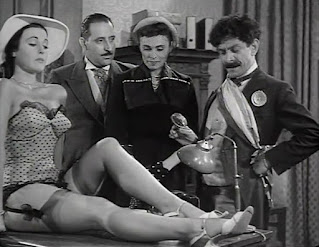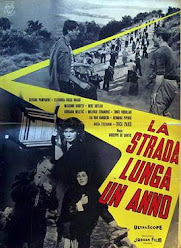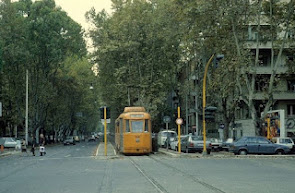Roman from theatrical family made more than 100 films
The actor Mario Carotenuto, who became one of the most familiar faces in the commedia all’italiana genre of Italian film, was born on this day in 1916 in Rome..jpg)
Mario Carotenuto forged a career
as a character actor in comedies
Carotenuto, who was active in the movie industry for more than 30 years having started in the theatre and on radio, acted alongside some of the greats of Italian cinema, including Totò, Alberto Sordi, Vittorio De Sica, Sophia Loren and Monica Vitti.
More often than not, he was cast in supporting roles rather than as the star, yet became respected as one of Italy’s finest character actors in comedy, winning a Nastro d'argento award for Best Supporting Actor for his portrayal of The Professor in Luigi Comencini’s 1973 comedy-drama Lo scopone scientifico - The Scientific Card Player - which starred Sordi, Silvana Mangano and the American Bette Davis.
Carotenuto was born into an acting family. His father, Nello, made a living in Italian silent movies, while his older brother, Memmo, also had a long career in films. His nephew, Bruno, and his niece, Nennella, also entered the acting profession.
He made his stage debut at the age of eight but is said to have had a rebellious nature as a child and his involvement in petty crime and antisocial behaviour saw him receive part of his education in a reform school.
As he matured, he became fascinated with theatre and acting and alongside various jobs he took in order to earn money he was always on the lookout for opportunities to act, one of which came with a radio station in Florence, where he was given parts in radio drama productions.
.png) |
| Carotenuto's acting style was perfect for the highly popular commedia all'italiana genre |
Carotenuto’s interpretation of the role gained the approval of Brecht himself and won him the San Ginesio Prize, awarded by a Milan-based magazine. He went on to have roles in plays by Shakespeare, Pirandello, Molière, Harold Pinter and Tennessee Williams.
After making his film debut in 1950, his ability to portray a broad range of characters soon saw him an actor much in demand, particularly in the comedy genre, working for famous directors such as Alberto Latuarda, Dino Risi, Mario Monicelli, Luigi Comencini, Luigi Zampa and Ugo Tognazzi.
Ultimately, his most popular roles were those in which his character was one with which many Italians could identify in the years after the war, a character looking to make his way in a changing society in which generally people looked forward with optimism.
Federico Fellini used him as the voice of the actor Mario Cannochia in Otto e mezzo (8 ½).
Carotenuto's simple memorial at
the cemetery of Grottammare
Carotenuto had many television credits as well as his long list of movie roles but ceased to be active in either medium in the early 1980s, dividing his time between Rome and the seaside town of Grottammare in Marche, the home of his second wife, theatre actress Gabriella Cottignoli.
He had been married previously to Luisa Poselli, an actress, singer and dancer, with whom he had a daughter, Claretta, who went on to become an actress and director.
He died in Rome in the Aurelia Hospital in April 1995 at the age of 79, having for many years been ill with lung cancer. His funeral took place in the Basilica of Santa Maria del Popolo - the 'church of the artists' - and was attended by many personalities of cinema and entertainment. His body was then taken to be buried in the municipal cemetery at Grottammare.
Travel tip:Rome's principal opera house, the Teatro dell'Opera
di Roma, was originally the Teatro Costanzi
Carotenuto made his stage debut at the Teatro Costanzi in Via del Viminale, a short distance from Piazza della Repubblica. Today the theatre has a different identity as the Teatro dell'Opera di Roma - Rome’s main opera house. Built in 1879-80, it takes its name from Domenico Costanzi, a contractor, who financed the project. It was designed by the Milanese architect Achille Sfondrini, a specialist in the building and renovation of theatres. Built on the site of the house of the Roman emperor Elagabalus, the theatre was inaugurated in November 1880 with a performance of Semiramide by Gioachino Rossini. Sfondrini paid particular attention to the acoustics of the theatre, the dome of which was adorned with frescoes by Annibale Brugnoli. As well as the world premiere of Pietro Mascangi's Cavalleria rusticana, the theatre staged the first production of Tosca by Giacomo Puccini in January 1900 and introduced Roman audiences to Puccini’s La fanciulla del West, Turandot and Il trittico as well as Richard Wagner’s Parsifal and Modest Mussorgsky’s Boris Godunov.
Travel tip:
Piazza Peretti is the central square of the older part
of Grottammare, which sits above the resort
Grottammare, where Carotenuto is buried, is one of the beach resorts that make up the Marche region’s Riviera delle Palme, a stretch of coastline around the larger town of San Benedetto del Tronto. It is notable for a fine, sandy beach but also for the well preserved remains of a fortress overlooking the town that was built following the sacking of Grottammare by the Montenegrin Princes of Dulcigno in 1525. The centre of the older part of the town is Piazza Peretti, a square enclosed by the Church of San Giovanni Battista, the Town Hall, Municipal Tower and Teatro dell'Arancio. A peculiarity of which the administration of Grottammare takes pride is that it sits on the 43º parallel, the line of latitude that also passes through the cities of Assisi (Italy), Santiago de Compostela (Spain), Lourdes (France), Medjugorje (Bosnia), Vladivostok (Russia), Sapporo (Japan), Buffalo and Milwaukee (United States).
Also on this day:
1961: The birth of novelist Gianrico Carafiglio
1986: The birth of heiress Allegra Versace
_facciata_piacentini_1010030.JPG)



































